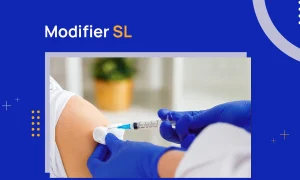Getting paid fairly for surgical procedures depends on correct coding. That’s especially true for gynecological procedures, in which different but closely related procedures are billed using different CPT codes. Do you know that insurance companies deny nearly 17% of in-network claims? A big reason behind this is inaccurate billing and errors in claim filing.
For critical gynecological procedures, this denial rate is highly concerning for both healthcare providers and patients. One code that is particularly important in gynecological procedures is CPT code 58570. Many medical billers don’t know how to file this code correctly.
We developed this guide after noticing frequent confusion surrounding CPT code 58570’s usage, documentation requirements, and modifier application. So, let’s start.
CPT Code 58570 Description
CPT code 58570 represents “Laparoscopy, surgical, with total hysterectomy, for uterus 250 g or less.”
The code describes a minimally invasive approach where a surgeon removes both the uterus and cervix (total hysterectomy) using laparoscopic techniques. An important point that billers miss is that CPT code 58570 must only be used when the uterus weighs 250g or less.
Let’s break down the procedure in simple terms.
Surgeons perform this procedure by making several tiny incisions in the patient’s abdomen. Through these small openings, they insert a camera (laparoscope) and other instruments. The surgeon detaches the uterus and cervix from surrounding structures. He then removes them either through the small incisions or through the vagina.
It is important to note that CPT code 58570 is part of a family of laparoscopic hysterectomy codes that vary based on the weight of the uterus and whether the procedure includes the removal of tubes and/or ovaries. Some related codes of this family are:
- 58570: Total hysterectomy for uterus 250g or less
- 58571: Total hysterectomy with removal of tube(s)/ovary(s), uterus 250g or less
- 58572: Total hysterectomy for uterus over 250g
- 58573: Total hysterectomy with removal of tube(s)/ovary(s), uterus over 250g
Please note that the word “Total” in these codes indicates that both the uterine body and cervix are removed. This makes CPT code 58570 different from supracervical procedures (58541-58544), where the cervix is not removed.
Appropriate Use Cases for CPT Code 58570
Surgeons don’t perform hysterectomies without a good reason. This procedure is performed only when other non-invasive treatments have not worked. The following are some clinical situations in which CPT code 58570 can be used:
Abnormal Uterine Bleeding
Some women experience persistent, heavy, or irregular uterine bleeding that does not respond to mild treatments. Initially, doctors try to treat this condition with hormonal medications, endometrial ablation, or other conservative treatments.
The condition may be due to hormonal imbalances, polyps, or structural abnormalities in the uterus. When these treatments don’t work, the gynecologist may suggest a total hysterectomy as a permanent cure.
Adenomyosis
Adenomyosis is a critical condition. It occurs when the endometrial tissue invades the muscular lining of the uterine wall. This results in extremely painful periods, chronic pelvic pain, and a lot of bleeding. Since adenomyosis involves the uterine muscles directly, hysterectomy offers the only definitive cure.
Cancer Prevention
Some women, usually between the ages of 35-44, have a significant risk of developing uterine or cervical cancer. The risk is mainly due to genetic reasons, and even females with no history of gynecological problems can suffer from it.
So, as a preventive measure, some women opt for a hysterectomy to prevent the progression of cancer. The procedure has its own risks and drawbacks, but it significantly reduces the chances of fatal cancer.
However, a total hysterectomy should not be performed without any substantial evidence. Healthcare providers must provide a definitive diagnosis and justification for this treatment approach.
Modifiers to Append with CPT Code 58570
The following modifiers are commonly used with CPT code 58570:
Modifier 22
This modifier indicates that the work done to provide a service was much greater than typically required.
Used when multiple procedures are performed during the same operative session.
Modifier 53
It is used when a procedure is started but discontinued due to extenuating circumstances.
Modifier 59
Identifies distinct procedures or services that are not normally reported together but are appropriate under certain circumstances.
Modifier 62
Used when two surgeons of different specialties work together as primary surgeons.
Modifier 80
Indicates that another physician assisted during the procedure.
Remember that improper use of modifiers can lead to claim denials or audits. So, always ensure that each modifier is backed by comprehensive documentation and proof.
Reimbursement Guidelines for CPT Code 58570
Surgeons deserve fair compensation for their work. However, getting paid appropriately for laparoscopic hysterectomies requires understanding various reimbursement factors. Let’s break down what you need to know:
Medicare Reimbursement
Medicare currently pays around $788.37 nationally for CPT code 58570, according to the 2025 Physician Fee Schedule. This code carries 13.36 work RVUs, which clearly shows the technical skills and time required for the procedure.
However, this amount is the national average, and the actual payment varies for each location. This fluctuation is because of geographic practice cost indices (GPCIs) that adjust for regional cost differences.
Documentation Requirements
Want to avoid payment denials? Strong documentation makes all the difference. Your records should include:
Pre-operative Documentation:
- Clear documentation of failed conservative treatments
- Impact of symptoms on the patient’s quality of life and daily functioning
- Physical exam findings supporting the diagnosis
- Results of relevant imaging or lab work
- Discussion of alternatives, risks, benefits, and informed consent
- Specific pre-operative diagnoses with ICD-10 codes
Operative Report:
- Detailed description of the procedure
- Documentation of the laparoscopic approach
- Confirmation that both the uterus and cervix were removed
- Clear documentation of the uterine weight (must be 250g or less)
- Any complications or additional procedures performed
Pathology report:
- Confirmation of uterine weight
- Pathological findings
Bundled Services
Several procedures are already included in CPT code 58570’s payment and should not be billed separately. Some of these bundled procedures and services are:
- Diagnostic laparoscopy
- Routine lysis of adhesions (extensive lysis might warrant separate coding)
- Abdominal exploration
- Vaginal cuff closure
- Obtaining hemostasis
Global Period
CPT code 58570 carries a 90-day global period for Medicare and most commercial payers. During this time, routine post-operative care is included in the surgical payment.
Final Thoughts on CPT Code 58570
CPT code 58570 is used to bill a laparoscopic total hysterectomy for a uterus weighing 250g or less. Before filing the claim, ensure you have used the correct CPT code, modifiers, and documentation to justify the procedure.
By following the guidelines in this blog, healthcare providers and billers can successfully file a claim with CPT 58570 and reduce the denial rate. If you are struggling with gynecology claim reimbursements and facing continuous denials, contact our medical billing consultants for the best OBGYN billing services.



